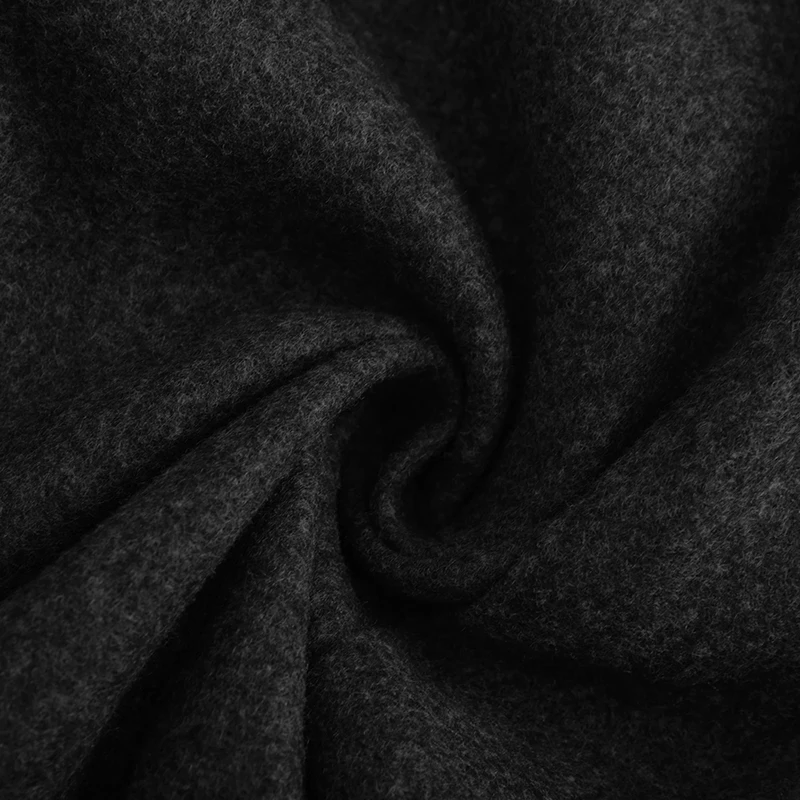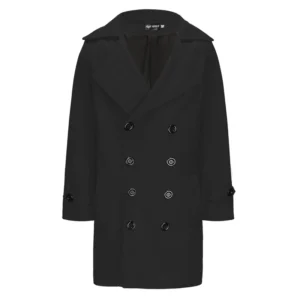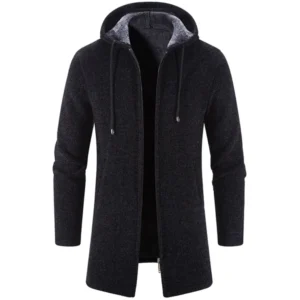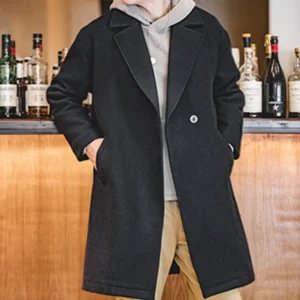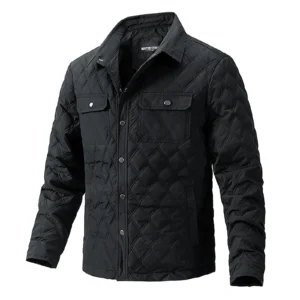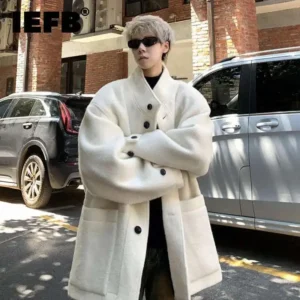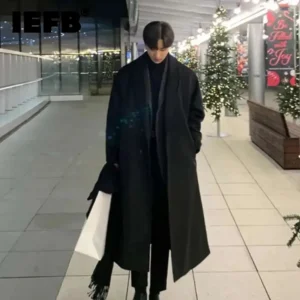The Enduring Appeal of the Classic Navy Pea Coat
Few garments in men’s fashion carry the same timeless appeal and versatility as the classic navy pea coat. With its rich heritage dating back to naval uniforms, this iconic piece has transcended its utilitarian origins to become a cornerstone of stylish wardrobes worldwide. What makes the pea coat truly special is how little its core design has changed over time – the signature double-breasted front, broad lapels, and distinctive anchor buttons remain virtually unchanged from the original military specifications.
The pea coat’s journey from functional maritime wear to fashion staple speaks to its exceptional design. Originally created to shield sailors from harsh sea conditions, its practical features proved equally valuable on city streets. The coat’s silhouette strikes that rare balance between rugged masculinity and refined elegance, making it adaptable across casual and formal settings alike.
What’s particularly remarkable about this garment is its staying power. While fashion trends come and go, the navy pea coat has maintained its relevance through decades of changing styles. This persistent popularity isn’t merely nostalgia – it’s a testament to the coat’s genuine versatility and flattering proportions that complement various men’s pea coats styles and body types.
The pea coat represents something increasingly rare in modern fashion: an investment piece that won’t feel dated next season. Its classic proportions and thoughtful details ensure it pairs as beautifully with contemporary casual wear as it does with more traditional attire. Understanding how choosing right coat length affects your overall appearance becomes especially important with such a versatile garment.
Understanding the Perfect Fit: The Foundation of Pea Coat Style
Before exploring the many styling possibilities, we must first establish the fundamental principle of pea coat style: proper fit is everything. No matter how well you coordinate your outfit, an ill-fitting pea coat will undermine your entire look. A well-fitted pea coat should:
- Sit comfortably across the shoulders without restriction or excess fabric
- Allow enough room for light layering underneath without appearing bulky
- End just below the hips, typically covering the seat of your pants
- Feature sleeves that reach your wrist bone when arms are relaxed
- Close comfortably without strain on the buttons or fabric pulling
Your body type naturally influences how a pea coat will sit on your frame. Taller men may benefit from slightly longer styles that maintain proportion, while shorter men often look best in more cropped versions that don’t overwhelm their silhouette. The perfect coat length for height creates a balanced appearance that flatters your natural proportions.
Common fit mistakes include choosing oversized coats that create a shapeless appearance or selecting styles too slim that restrict movement and prevent layering. Remember that a pea coat should feel substantial and protective without swallowing your frame. The right fit creates a strong shoulder line that enhances your natural physique.
Understanding the differences between classic fit vs slim fit pea coats helps you select the most flattering option for your build. Classic fits offer more room throughout the body and arms, making them ideal for layering and comfortable daily wear. Slim fits create a more tailored appearance that works beautifully with contemporary wardrobes but may limit layering potential.
Essential Casual Looks for Men
The pea coat’s greatest strength may be its remarkable versatility in casual settings. This traditional outerwear piece elevates everyday looks without appearing overdressed, creating that perfect balance between effortless and intentional style.
For weekend outings and casual gatherings, try these foolproof combinations:
- Dark wash straight-leg jeans + white henley + chukka boots
- Medium wash jeans + gray crewneck sweatshirt + leather sneakers
- Black jeans + chambray button-down + Chelsea boots
- Khaki chinos + navy crewneck sweater + desert boots
The navy pea coat particularly shines against lighter-colored casual wear, creating natural contrast that draws attention to the coat’s structured silhouette. Consider your denim wash carefully – darker jeans create a more cohesive look, while medium washes introduce pleasing contrast.
For tops, comfortable layers work beautifully. T-shirts serve as perfect foundations in milder weather, while henleys, lightweight sweaters, and casual button-downs add visual interest and warmth. The texture contrast between the coat’s wool and softer underlying fabrics creates visual depth.
Footwear should complement the coat’s rugged-refined balance. Boots like chukkas or desert boots echo the pea coat’s maritime heritage, while clean leather or canvas sneakers modernize the look. The versatility of wool pea coats makes them particularly adaptable to different casual styling approaches.
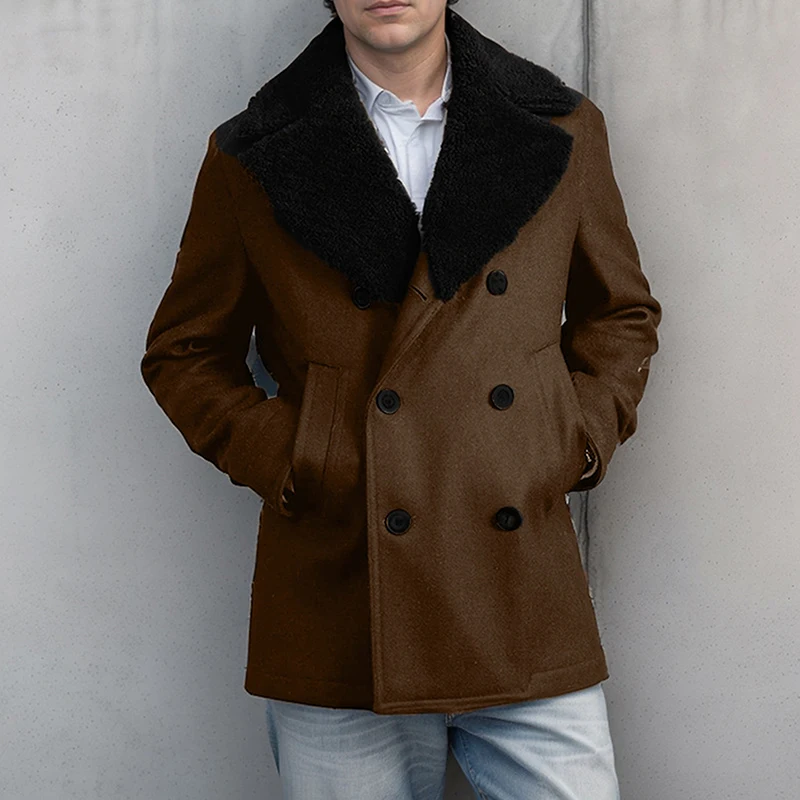
Smart Casual and Business Styling for Men
When elevating your pea coat for more refined contexts, thoughtful coordination becomes especially important. The coat’s structured nature makes it a natural companion for business casual and smart casual settings.
For office-appropriate styling, consider these combinations:
- Gray wool trousers + light blue Oxford shirt + brown leather brogues
- Navy chinos + white button-down + burgundy loafers
- Charcoal dress pants + turtleneck sweater + black Chelsea boots
- Olive chinos + striped shirt + tan desert boots
The key to business casual styling lies in balancing the pea coat’s inherent structure with equally refined pieces. Well-tailored trousers in wool or cotton twill create a cohesive foundation, while properly fitted shirts maintain clean lines throughout your look.
Layering becomes particularly important in professional settings. Consider adding fine-gauge sweaters over button-downs or incorporating lightweight vests for additional warmth without bulk. These intermediate layers not only provide practical warmth but also create visual dimension when your coat is unbuttoned.
Footwear should lean toward the refined end of the spectrum. Clean leather shoes like brogues, Oxfords, or minimal boots complement the coat’s structured nature. Be mindful of men’s coat length style guide principles to ensure your proportions remain appropriate for professional environments.
Accessories play a crucial role in business casual styling. Consider adding leather gloves, a simple wool scarf, or a structured leather bag to complete your look. These finishing touches should complement your outfit without overwhelming it.
Advanced Styling: Dressing Up Your Pea Coat
While traditionally considered casual to business casual outerwear, the pea coat can venture into more formal territory with thoughtful styling. Understanding its limitations and strengths helps you push boundaries appropriately.
The pea coat works surprisingly well over tailored separates like blazers and dress trousers. The key is ensuring proper proportions – your pea coat must be sized to accommodate these additional layers without appearing strained. Look for styles with slightly more room through the chest and shoulders if you plan to layer over tailored pieces.
For elevated evening occasions, try:
- Charcoal suit (minus jacket) + white dress shirt + black Oxford shoes
- Navy blazer + gray wool trousers + burgundy knit tie + brown brogues
- Black dress pants + charcoal turtleneck + black Chelsea boots
While the pea coat can complement formal wear, recognize its limitations. Traditional black-tie events generally call for overcoats rather than pea coats. However, for semi-formal gatherings, theater outings, or upscale restaurants, a well-styled pea coat strikes the perfect balance between sophistication and approachability.
The double-breasted pea coat particularly excels in formal-leaning contexts, as its structured front closure and defined lapels echo elements found in tailored suiting. This visual harmony creates a cohesive appearance even in more elevated settings.
Women’s Pea Coat Styling: Casual Elegance
The classic navy pea coat translates beautifully to women’s wardrobes, offering the same versatility with uniquely feminine styling potential. For casual occasions, the coat adds structured polish to relaxed pieces.
Consider these effortlessly elegant combinations:
- Skinny jeans + oversized sweater + ankle boots
- Boyfriend jeans + striped boatneck top + white sneakers
- Leggings + longline tunic + riding boots
- Casual dress + tights + combat boots
The contrast between the coat’s structured silhouette and more relaxed casual pieces creates an appealing visual balance. This juxtaposition reads as intentional rather than haphazard, elevating even the simplest jeans-and-sweater combination.
Layering takes on particular importance in women’s casual styling. Consider adding scarves, lightweight knits, or even hoodies underneath for both practical warmth and textural interest. The coat’s clean lines provide a perfect structured frame for these softer elements.
Accessories should complement the coat’s maritime heritage. Consider leather bags with minimal hardware, simple gold jewelry, or patterned scarves that incorporate navy to create a cohesive look. These thoughtful additions enhance the coat’s inherent elegance without competing for attention.
Women’s Pea Coat Styling: Sophisticated and Professional
In professional settings, the women’s pea coat demonstrates remarkable versatility across different workplace dress codes. Its structured shoulders and defined waist create a flattering silhouette that complements tailored workwear beautifully.
For office-appropriate styling, consider:
- Pencil skirt + silk blouse + pointed-toe heels
- Tailored trousers + cashmere sweater + leather loafers
- Sheath dress + tights + ankle boots
- Wide-leg pants + fitted turtleneck + block heels
Proportion becomes especially important when styling for professional settings. The pea coat’s typically shorter length creates pleasing balance with both skirts and trousers, while its defined waist prevents the boxy silhouette that can overwhelm petite frames.
When styling with dresses or skirts, consider length relationships carefully. Ideally, your dress or skirt should extend beyond your coat hem to maintain visual flow. This approach creates clean lines that enhance the coat’s structured elegance.
Layering for professional environments should prioritize sleek, minimal pieces that won’t create unnecessary bulk. Fine-gauge knits, silk blouses, and lightweight wool sweaters provide warmth without compromising the coat’s clean silhouette.
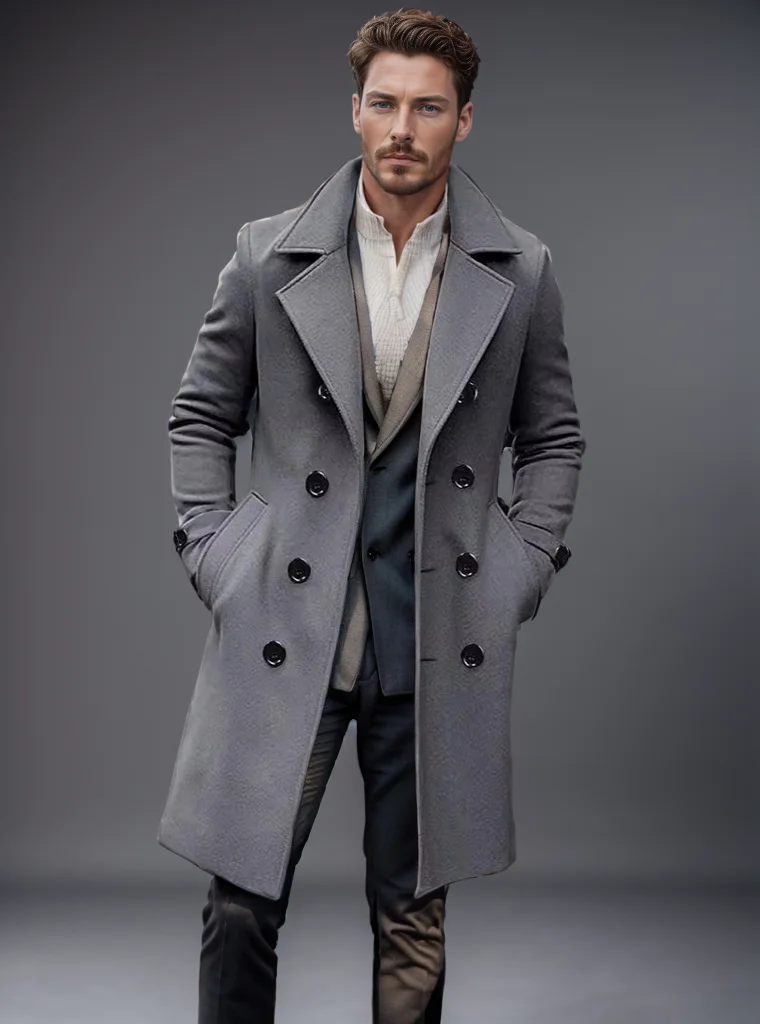
Mastering Accessories with Your Navy Pea Coat
Accessories transform a simple navy pea coat outfit into a complete, thoughtful look. The coat’s rich navy color creates a perfect neutral backdrop for both complementary and contrasting accessories.
For scarves, consider these approaches:
– Complementary tones: burgundy, camel, or forest green wool scarves
– Contrasting brightness: mustard yellow or burnt orange knits
– Pattern play: subtle plaids, small-scale stripes, or herringbone patterns
Hats require careful consideration with pea coats. Structured options like wool fedoras or flat caps echo the coat’s military heritage, while knit beanies create appealing textural contrast. Avoid overly casual options like baseball caps, which can clash with the coat’s inherent formality.
Gloves should balance practicality with style. Leather options in brown, black, or burgundy complement the coat’s refined nature, while wool or cashmere knits in complementary colors introduce pleasing texture. Consider touchscreen-compatible styles for maximum functionality.
Bags should maintain proportion with your overall silhouette. Structured leather messengers, sleek backpacks, or classic briefcases complement the coat’s heritage aesthetic. Avoid overly casual options like gym bags or excessively decorated styles that compete with the coat’s clean lines.
The principles above apply universally, though specific accessory choices may vary between genders. The key is maintaining balance – your accessories should enhance your mens overcoats rather than overshadow them.
Color Theory: Building Palettes Around Your Navy Coat
Understanding color theory transforms how you style your navy pea coat, creating intentional looks that highlight the coat’s versatility. Navy functions as a neutral foundation, allowing remarkable flexibility in color combinations.
Complementary Approach:
Navy’s complementary colors include warm oranges and rich yellows. While wearing head-to-toe orange would overwhelm, incorporating these hues through accessories (a burnt orange scarf) or subtle accents (cognac leather boots) creates energetic visual interest.
Analogous Combinations:
Colors adjacent to navy on the color wheel – purples, blues, and cool greens – create harmonious, sophisticated palettes. These combinations read as intentional and refined, perfect for professional environments or elegant evening wear.
Monochromatic Strategy:
Varying shades of blue create depth while maintaining a cohesive appearance. Consider pairing your navy coat with lighter blue shirts, medium-wash jeans, and dark blue accessories for a thoughtfully coordinated look with visual dimension.
Seasonal considerations also influence ideal color pairings. Fall calls for rich earthy tones like burgundy, olive, and mustard, while winter welcomes deeper jewel tones and crisp black and white combinations. Spring invites lighter blues, soft greens, and gentle neutrals that complement the coat without creating stark contrast.
The best colors classic fit pea coats often depend on your personal coloring and style preferences, but these fundamental principles provide a solid foundation for building coherent, flattering palettes.
Styling for Different Seasons and Weather Conditions
While typically associated with colder months, the navy pea coat demonstrates surprising adaptability across seasons with thoughtful layering and fabric selection.
Fall Styling:
In early autumn, layer your pea coat over lightweight pieces like cotton button-downs or fine merino sweaters. This season welcomes versatile combinations:
– Lightweight chinos + plaid flannel shirt + desert boots
– Dark jeans + thin sweater + leather sneakers
– Khaki pants + chambray shirt + chukka boots
Winter Approaches:
As temperatures drop, incorporate heavier layers beneath your coat:
– Thermal henley + flannel shirt + thick jeans + insulated boots
– Heavy sweater + wool trousers + winter boots
– Insulating vest + oxford shirt + wool blend pants + lined shoes
Winter accessories become crucial for both style and function. Consider wool scarves in complementary colors, insulated gloves, and knit hats that provide warmth without compromising your look’s cohesion. Understanding the perfect winter coat length guide helps maximize both warmth and style during the coldest months.
Transitional Weather:
During unpredictable transitional seasons, adaptable layering becomes essential:
– Weather-appropriate base layer + removable mid-layer + pea coat
– Water-resistant shoes to handle unexpected precipitation
– Scarves and gloves that can be easily stored if temperatures rise
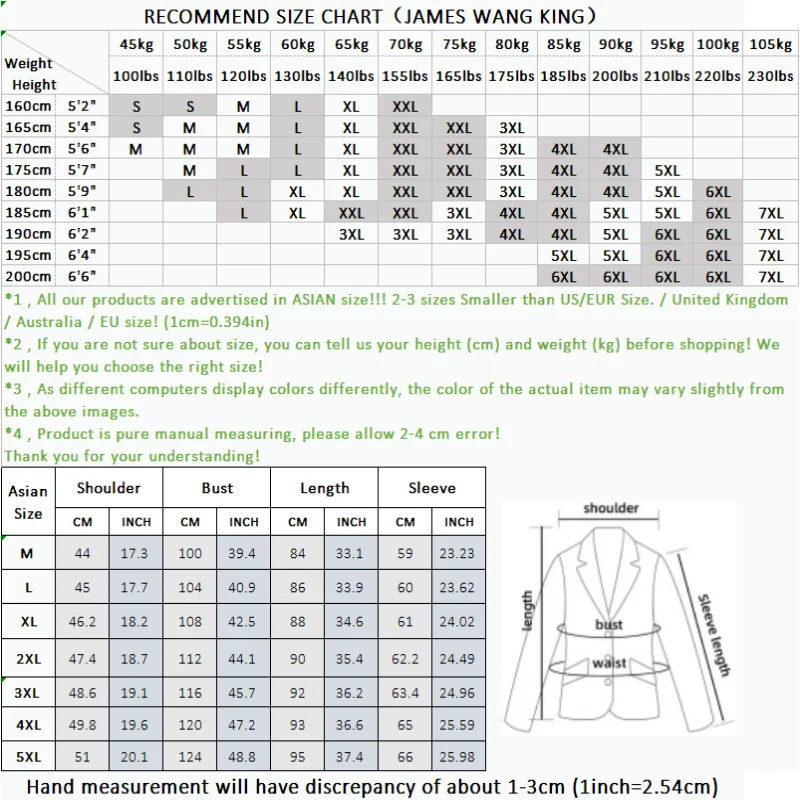
Common Styling Mistakes to Avoid
Even this versatile classic can fall victim to common styling pitfalls that undermine its potential. Being aware of these mistakes helps you maximize your pea coat’s impact:
Neglecting proper fit: Perhaps the most critical error, an oversized or too-tight pea coat immediately diminishes your entire look. Solution: Focus on shoulder fit first, ensuring the seams align with your natural shoulder edge.
Ignoring proportions: Pairing a pea coat with unbalanced pieces (extremely baggy pants or overly tight shirts) creates visual disconnect. Solution: Maintain consistent proportions throughout your outfit.
Overlooking layering logistics: Attempting to wear bulky sweaters under a fitted coat creates uncomfortable bunching and restricted movement. Solution: Choose thinner, insulating layers specifically designed for layering.
Mismatching formality levels: Combining very formal elements (tuxedo pants) with very casual ones (graphic tees) creates jarring contrast. Solution: Keep all elements within one or two degrees of formality from each other.
Competing statement pieces: Pairing your distinctive coat with other bold items creates visual competition. Solution: Let your pea coat be the focal point, supporting it with more subdued complementary pieces.
Understanding proper classic mens overcoats formal wear principles helps you navigate the balance between casual and refined styling, ensuring your pea coat enhances rather than confuses your overall aesthetic.
Styling & Care: Maintaining Your Pea Coat’s Appeal
The relationship between proper care and successful styling cannot be overstated. A well-maintained pea coat retains its structured silhouette and rich color, while neglected garments quickly lose their impact.
For routine maintenance, brush your coat regularly with a garment brush to remove surface debris before it becomes embedded in the wool. Address minor spots promptly using a damp cloth and gentle blotting motion rather than vigorous rubbing that can damage fibers.
Professional dry cleaning should be limited to once or twice per season, as excessive cleaning can degrade the wool’s natural properties. Between cleanings, air your coat out after wearing by hanging it on a sturdy wooden hanger in a well-ventilated area.
Proper storage proves equally important. During warmer months, clean your coat thoroughly, then store in a breathable garment bag with cedar blocks to deter moths. Avoid plastic covers that trap moisture and potentially lead to mildew development.
Watch for early warning signs that your coat needs attention: unusual wrinkling that doesn’t release with hanging, persistent odors, or visible wear at stress points like elbows and cuffs. Addressing these issues promptly preserves both appearance and longevity.
Mens Double Breasted Pea Coat, Mens Wool Blend Coat, Mens Wool Pea Coat
Price range: $136.84 through $157.36 Select options This product has multiple variants. The options may be chosen on the product pageMens Cashmere Overcoat, Mens Hooded Winter Coat, Mens Wool Blend Coat
Price range: $128.72 through $139.68 Select options This product has multiple variants. The options may be chosen on the product pageMens Black Overcoat, Mens Black Wool Coat, Mens Wool Overcoat
$339.18 Select options This product has multiple variants. The options may be chosen on the product pageMens Double Breasted Pea Coat, Mens Hooded Winter Coat, Mens Quilted Coat
Price range: $81.00 through $108.48 Select options This product has multiple variants. The options may be chosen on the product pageMens Grey Overcoat, Mens Wool Blend Coat, Mens Wool Overcoat
$201.28 Select options This product has multiple variants. The options may be chosen on the product pageMens Herringbone Coat, Mens Long Overcoat, Mens Wool Overcoat
Price range: $197.16 through $203.69 Select options This product has multiple variants. The options may be chosen on the product page
Making the Pea Coat Your Own: Personal Style Expression
While styling guidelines provide valuable framework, the most successful pea coat looks reflect individual personality and preferences. This classic piece serves as an exceptional canvas for personal expression.
Consider how your existing wardrobe and style identity might interact with this versatile garment. Those with minimalist tendencies might pair their pea coat with monochromatic outfits and architectural accessories, while vintage enthusiasts could lean into the coat’s heritage with traditional patterns and complementary historical pieces.
Don’t hesitate to challenge traditional styling boundaries. The pea coat’s enduring appeal stems partly from its adaptability across different interpretations – from strictly classic to boldly contemporary. Experimenting with unexpected color combinations, modern silhouettes, or unique accessories often yields surprisingly successful results.
Remember that confidence ultimately determines how well any garment works for you. A pea coat styled in alignment with your personal aesthetic will always look more authentic than rigidly following external guidelines. Understanding the differences between short vs long coats guide helps you select the variation that best complements your individual style and proportions.
The classic navy pea coat stands as one of menswear’s most enduring pieces precisely because it welcomes such personal interpretation while maintaining its fundamental character. By mastering its styling principles and making them your own, you unlock the full potential of this remarkable wardrobe investment.

